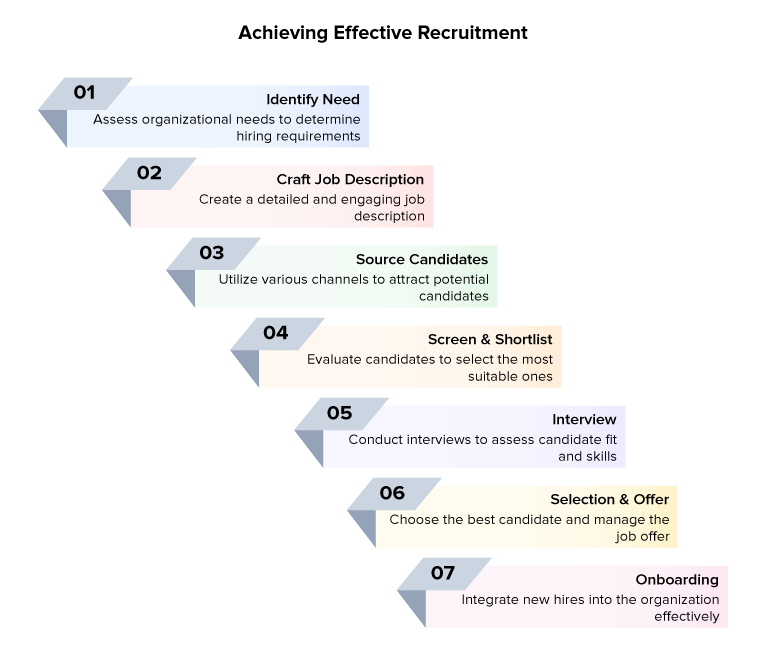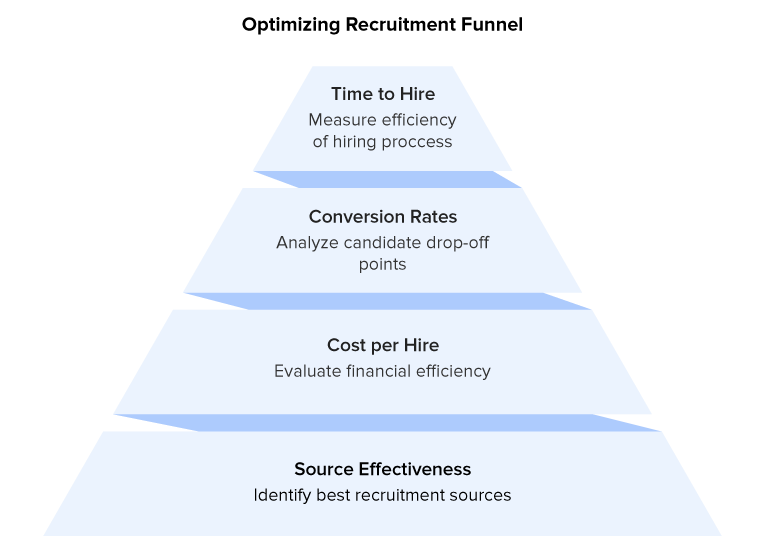Recruitment Process: 7 Steps to Hire Faster in 2026

Table of Contents
Nowadays, the recruitment process has become more challenging than it was a decade ago. You need speed in screening candidates and accuracy in sorting the potential ones for the next round. So, how can a business recruit faster with accuracy?
By leveraging the best techniques powered by advanced technologies. This article explains how to streamline the HR recruitment process in seven steps. Additionally, learn about common mistakes to avoid and the best tools to utilize for optimizing the recruitment funnel.

Key Takeaways
Importance of a robust recruitment process:
Understand how a well-structured recruitment process builds a strong workforce, improves retention, and ensures cultural alignment across the organization.
Streamline hiring in 7 steps:
Explore the essential recruitment process steps, from identifying a job need to onboarding, that make hiring structured, fair, and efficient.
Recruitment funnel optimization:
Learn how to fine-tune each stage of the recruitment funnel to attract better candidates, shorten hiring cycles, and reduce drop-off rates.
Common mistakes to avoid:
Identify frequent hiring errors, such as unclear job descriptions, poor communication, or lack of data tracking, and discover ways to prevent them.
Productivity tools for easy recruitment:
Discover how AI-powered software, Applicant Tracking Systems (ATS), and automation tools save time, cut costs, and simplify recruiter workloads.
Future trends in recruitment process:
Stay ahead with insights on how AI, analytics, and automation are reshaping the future of hiring, making recruitment faster, smarter, and more human-centered.
What is the Recruitment Process?
If you’re new to HR, learning what is meant by the recruitment process is the first step toward mastering talent acquisition. The recruitment process is a series of steps that organizations follow to find, attract, screen, interview, select, and onboard qualified candidates for open positions. This process includes everything from identifying a staffing need to successfully filling that position.
Take an example of a business that needs an accountant. Now, how will the business select an accountant? First, hiring teams will identify what type of accounting the organization needs. Based on these needs, they will plan the recruitment.
The hiring team will execute the HR recruitment process steps. The team will source talent from across job boards, shortlist candidates, conduct interviews, and select the most suitable one. However, the recruitment process does not end here; it continues until the new candidate is fully integrated into the existing workflows.
What is the Importance of a Robust Recruitment Process?
A robust recruitment process ensures a transparent hiring process. Plus, it creates a great impression on candidates, even if they don’t land the job. And that matters because every applicant helps boost an organization’s reputation in the job market.
When the company’s recruitment process is robust, it will not encounter significant issues when hiring for a new project that requires specialized skills. Plus, they can leverage AI recruitment demand forecasting. 88% of companies already use AI for initial candidate screening. Therefore, leveraging AI can help streamline the recruitment process.
Now that you know why it’s important, let’s understand the key steps in the recruitment process.
Related: AI and Machine Learning in Recruitment

7 Steps in the Recruitment Process for 2026
Here are the key recruitment process steps that businesses can follow for effective hiring:

Step 1: Identifying the Need for Recruitment
Several factors will influence the recruiting process, and to identify them, ask the following questions,
- What are the specific skills an organization needs?
- How will the hiring team plan the entire recruitment process?
- What should the organization’s approach be when sourcing candidates?
- How many candidates are required to be hired to fulfill organizational needs?
Step 2: Crafting Optimized Job Descriptions
Here is a checklist to optimize the job description for the recruitment process.
Checklist for Crafting the Perfect Job Description
- Job Title
- Job Summary
- Key Responsibilities
- Required Qualifications
- Preferred Qualifications
- Skills and Competencies
- Working Relationships
- Compensation and Benefits
- Company Overview
- Location and Working Conditions
- Application Process
- Legal Compliance
- Keep it Concise and Engaging
- Use Relevant Keywords
- Regularly Update
Related:Difference Between Job Description and Job Specification
Do’s and Don’ Ts of Writing a Perfect Job Description
| Do’s | Don’ts |
|---|---|
| Create a proper JD title | Avoid jargon, buzzwords, and overly optimistic language |
| Begin with an engaging summary to capture the reader’s interest | Avoid a job description with an extensive list of responsibilities |
| Concentrate on the most critical responsibilities and skills | Don’t overinflate or misrepresent the role |
| Divide between must-have and nice-to-have qualifications | Do not use discriminatory language or requirements |
| Show off the company’s culture, mission, and values | Don’t overlook important details |
| Add salary, benefits, and perks to increase transparency | Don’t forget to optimize for keywords related to the position |
Related: Expert Tips for Crafting an Outstanding Job Description
Step 3: Sourcing Candidates
Candidate sourcing includes identifying, attracting, and connecting with potential candidates to prepare for future hiring needs.
Internal Sources of Recruitment
- Promotions: Advancing existing employees to higher ranks based on their performance.
- Transfers: Employees move within the same level to different departments.
- Employee Referrals: Suggestions by the existing employees.
- Internal Job Posting: This is the advertisement for jobs within the company.
- Succession Planning: Expecting the current employees to be ready to take up a leadership position.
Related: Internal Recruitment Guide
External Sources of Recruitment
- Job Portals: Listing job openings on websites such as Naukri.com and LinkedIn
- Agencies: Employing a third-party agency to search for the perfect candidate.
- Education Bodies: Recruitment of fresh graduates from the campus.
- Social Media: Leverage networks like LinkedIn for targeted searches and outreach.
- Walk-ins and Job Fairs: Apply in person and go to recruitment events.
Related: Top 16 Job Portals in India 2025-26
Step 4: Leveraging Automated Candidate Screening Tools
By leveraging automated candidate screening, you instantly filter out 70% of unqualified resumes before a human ever sees them.
- Reviewing resumes for relevant experience, skills, and qualifications.
- Skill assessments to evaluate technical abilities.
- Checking references to verify past work experience.
Step 5: Interviewing Phase
The interview process typically includes several stages:
- Initial Screening: Phone or video interviews.
- First Interview: In-depth assessment of qualifications, experience, and fit.
- Assessment Stage: Practical tasks, such as aptitude tests or case studies.
- Second-Round Interview: More extensive assessments focusing on problem-solving abilities.
Step 6: Selection & Offer Management
Selection involves choosing the candidate who best fits the role and organizational culture. Offer management consists of extending a job offer letter, negotiating terms, and securing the candidate’s acceptance.
Key steps include:
- Presenting the offer clearly, covering compensation, benefits, and job responsibilities.
- Negotiating terms professionally if needed.
- Ensuring compliance with legal and recruitment policies.
- Securing prompt acceptance and guiding the candidate through the paperwork.
Step 7: Onboarding in Your Recruitment Process
Onboarding is the process of integrating new hires into the organization. It includes:
- Filling in required forms and regulatory requirements.
- Acclimatizing the new employee to the group and the organization’s culture.
- Training and resources to facilitate an easy transition.
- Establishing boundaries and objectives in the early stages is crucial for success.
- Positive values of a good recruiting process for the organization
Benefits of a Good Recruiting Process for the Organization
Here are some of the top benefits of a robust recruiting process.
| Benefits | Description |
|---|---|
| Better hiring quality | Data-driven candidate evaluation improves recruitment quality. |
| Less time for recruitment | Automation and AI streamline the sourcing and screening processes, speeding up the overall workflow. |
| Reduced cost | Reduced errors in the hiring process ensures that the streamlined process offers better cost efficiency. |
| More diversity | Data-driven tools reduce bias, supporting fair and inclusive hiring practices. |
| Better retention | A robust recruitment process provides a stable workforce. |
Measuring & Optimizing Your Recruitment Funnel with an Analytics Dashboard
Here is how to measure the recruitment funnel,


Key Recruitment Funnel Optimization Metrics
- Time‑to‑Hire Metrics: Track days from posting to accepted offer.
- Stage‑by‑Stage Conversion: Identify drop‑off points.
- Cost‑to‑Hire Analysis: Budget performance per hire.
- Recruitment Analytics Dashboard: Build a live dashboard to visualize these KPIs.
Here is how to fine-tune the recruitment funnel,
- Start with Clear Job Needs: Don’t confuse candidates. If the role isn’t well-defined, the whole funnel breaks.
- Balance Data with Insight: Metrics reveal the issues, but feedback from candidates explains why these issues arise.
- Understand Drop-off Rates: A big gap between interviews and offers can cause such issues, which can be resolved through proper communication.
- Tweak Regularly: Hiring isn’t a “set-it-and-forget-it” system. Review the results, make any necessary adjustments, and continually refine them over time.
Related: Top 10 Recruitment Strategies to Attract and Retain Employees

Common Recruitment Mistakes to Avoid
- Vague Job Descriptions: This confuses everyone and wastes time, both for the company and the candidates.
- Ignoring Team Culture Fit: A Perfect Resume Doesn’t Mean an Ideal Match. Culture misfits often don’t stick around.
- Speeding Through the Process: Quick Decisions Can Backfire. Organizations might miss red flags or overlook better fits.
- Prioritizing Degrees Over Skills: Experience counts, but hands-on ability matters more than a shiny certificate.
- Unstructured Interviews: “Let’s just chat” isn’t a strategy. HR professionals need consistency and skill-based evaluations.
- Skipping References: Avoiding a Major Hiring Mistake Only Takes a Call or Two.
- Failing to Sell the Role: Top talent has options. If organizations don’t market the opportunity, they’ll walk.
- Outdated Tools: Manual processes are slow and clunky. Today’s tech can automate and optimize almost everything.
- Thinking Cheating Won’t Happen: Keep things fair and honest, especially with remote assessments.
- Using Generic Tests: Customized, role-specific evaluations give far better insights than query-based surveys.
Related: 12 Most Common Recruitment Challenges and Solutions for HR Professionals
Productivity Tools to Simplify and Streamline the Recruiting Process
Here are some of the best productivity tools to streamline the recruiting process.
| Tool Name | Description |
|---|---|
| Google Drive | Keeps resumes, feedback, and notes organized in one shared space. |
| Calendly | No more back-and-forth emails; just send a link and let candidates choose. |
| Trello | A clean visual board to track every candidate’s status and hiring steps. |
| Boomerang for Gmail | Never forget to follow up — schedule emails and reminders in a click. |
| Wunderlist | Perfect for juggling to-dos between hiring teams and recruiters. |

Future Trends in Recruitment Process
The future hiring scenario will include maximum use of technology and data. Here’s how different technologies will transform the recruitment process steps in the coming years:
- AI-powered resume screening: Artificial Intelligence will scan resumes, match keywords, and rank candidates automatically. This will remove hours of manual shortlisting and reduce hiring costs.
- Machine learning for skill matching: ML algorithms will study past hiring data to predict which candidates are most likely to succeed. This reduces wrong hires and wasted training resources.
- Predictive analytics for workforce planning: Data analytics tools like Power BI and Tableau will forecast talent gaps and seasonal hiring needs, helping HR teams plan budgets better.
- Chatbots for candidate communication: AI chatbots will schedule interviews, answer FAQs, and send status updates instantly, freeing recruiters from repetitive tasks.
- Video interview automation: Platforms like HireVue and Spark Hire will use facial and voice analytics to evaluate candidate responses and reduce interview time.
- Blockchain for background checks: Blockchain-based verification will validate education, work history, and credentials in minutes instead of weeks. This ensures faster onboarding and fewer manual checks.
- Cloud-based ATS (Applicant Tracking Systems): Tools like Greenhouse and Lever will store and track all candidate data in one place, reducing paperwork and communication gaps.
Final Words
Each choice organizations make in the recruitment process impacts the workforce and the future of their business. The aim should be to hire the right individuals who can develop, evolve, and lead confidently.
Whether it’s improving your job posting strategy, avoiding common hiring mistakes, or using smart tools, every step matters. A well-designed recruitment approach not only attracts top talent but also strengthens your workplace culture, creating a strong base for long-term success.
Remember, during the start of the recruitment process, stay agile, data-driven, and focus on people. This is where factoHR recruitment software will help you. factoHR cuts time‑to‑hire by 40% with AI screening. The software is created to make the hiring experience easier and personalized. Curious how factoHR can simplify your hiring journey? Check out the demo now.
Related:
Recruitment and Selection Process: Best Practices & Overview
Recruitment Team Structure: Understanding the Key Roles

FAQs
What is Recruitment?
Recruitment refers to the practice of defining, drawing, and selecting the correct individual for a particular position. The process begins with identifying a hiring need, creating a proper job description, and concludes with integrating a new employee into the team. Recruitment is not merely about hiring, and it entails the development of mutual value between the organization and the individual.
How do You Build a Great Recruitment Team?
The jobs should be well defined in an effective recruitment team, and in most cases, the recruitment team comprises recruiters and coordinators. Analytical minds are best complemented on the most effective teams by emotional intelligence and communication skills.
How Long does the Recruitment Process Usually Take?
The schedules for hiring differ greatly. Certain positions are filled within a matter of days, whereas others, such as specialized or leadership-related roles, can take months. The position closure takes an average of 3-6 weeks. Keeping track of the time-to-hire allows for the noticing of possible delays and the optimization of the entire process.
What Exactly is the HR Recruiting Process?
HR recruiting encompasses the entire hiring process, which includes publishing job postings, sourcing candidates, reviewing applications, conducting interviews, administering tests, extending job offers, and onboarding new hires. Every phase must demonstrate compliance, inclusiveness, and congruence with the organization’s goals. A well-controlled HR procedure will also leave candidates with a sense of esteem and worth.
What is Recruitment in HRM?
In Human Resource Management, recruitment does more than just filling vacancies. It facilitates the strategic initiatives, including workforce planning, succession planning, and company culture. Recruitment is the beginning of the employee lifecycle and is thus fundamental in ensuring that the top talent retained is aligned with the organization’s mission.
Grow your business with factoHR today
Focus on the significant decision-making tasks, transfer all your common repetitive HR tasks to factoHR and see the things falling into their place.

© 2025 Copyright factoHR


